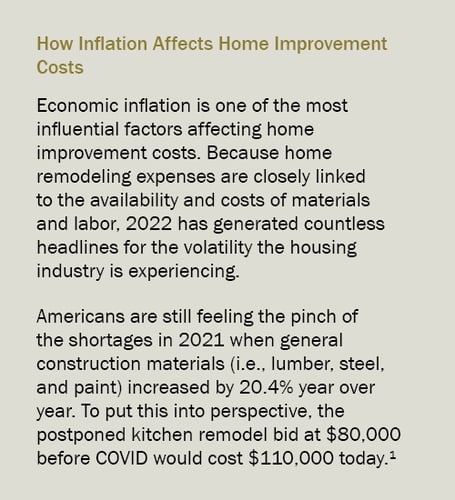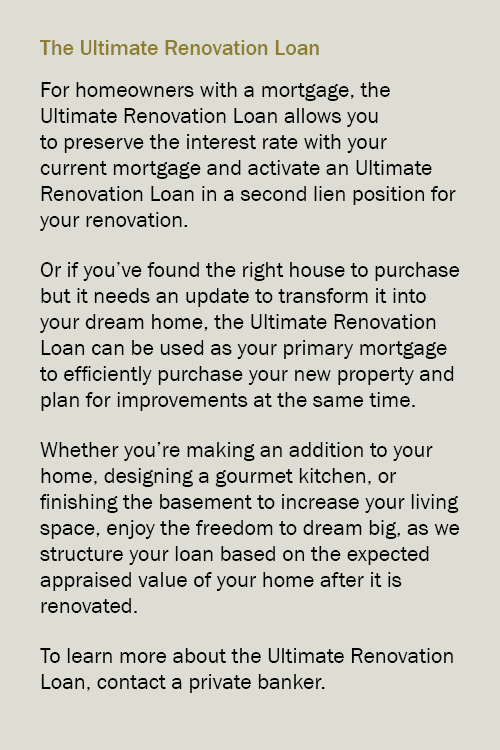
The U.S. home improvement industry is stronger than it has been in decades. Not only do remodeling projects encompass the sale of building materials, appliances, décor, and other enhancements, improvements made by property owners also include services from contractors, tradespeople, and other workers who help to build, install, modify, and upgrade their homes. The home improvement industry plays a significant role in the U.S. economy.
With a nationwide shortage of housing and record-high home prices — not to mention the effects of inflation — more and more homeowners are choosing to stay in their properties and make home improvements versus moving to new homes.
The cost of waiting to remodel
According to the Harvard Joint Center for Housing Studies, in 2022 the home remodeling market is projected to reach $432 billion — an increase of 17% over last year. In 2021, home remodeling projects generated $369 billion in revenue, an increase of 9% over 2020. The average annual growth rate for home remodeling is 4.4%² — which means the longer you wait likely the more you’ll pay for home improvements.
It’s no secret that the home remodeling market is extremely competitive and highly fragmented. Home improvement costs vary widely from one region of the U.S. to another, with price structures differing considerably based on geographic location, with no sign of costs trending downward. Cost quotes can even vary widely in the same city — you may have experienced this firsthand if you’ve ever gotten bids on one project from three different contractors.

When it pays to be trendy — and when it doesn’t
There are so many interesting options and technological enhancements homeowners can do to improve and upgrade their houses — it’s no wonder popular trends change from year to year. New changes are always on the horizon for upscale property improvements, including spacious chef-style kitchens, indoor and outdoor pools and spas, elaborate home offices, state-of-the-art home theatres and music rooms, and destination-themed bars and wine cellars.
However, if you want a good return on your remodeling investments, going with trendy improvements may not always be the smartest idea. Traditionally, the best remodels are likely to focus on upgrades that will enhance appearance or function now and continue to be attractive additions in the future.
Average cost to remodel a house
An average whole-house remodel runs between $15 to $60 per square foot or between $19,800 to $73,200, depending on the rooms being renovated and the size of the home. Kitchen and bathroom renovation costs run $100 to $250 per square foot based on size of the room and quality of materials. A complete gut renovation costs between $60 to $150 per square foot. Keep in mind any unforeseen
damages or structural changes made to the layout could add significantly to the overall cost of the remodeling project.³
Consider your return on investment (ROI)
The return on investment (ROI) is the bottom line if you’re looking to sell your home quickly and make a profit. If you plan on flipping your property soon, be aware of popular trends and what the likely return on remodeling costs will be for particular projects. To understand what’s getting the best returns in your area right now, it pays to do your homework. A local realtor is a good resource for up-to-date information.
Homeowners who have lived in their house more than six years make up 60% of the remodeling market. However, they generally spend 50% less than recent homebuyers who have lived in their house less than a year, spending around $30,000 on average remodeling projects. The average ROI for a home remodeling project is 56%.² However, depending on the size of the home, scale of the upgrade, and location of the property, a remodeling project could generate much higher returns, especially for higher-end homes.

Paying for your home improvements
Should you decide it’s time to dream big and finance your home addition or home improvement project rather than paying cash, home equity lines of credit are one possible option. We offer a home equity line with no bank fees at closing. Or, depending on the terms of an existing first mortgage, a refinance cash-out mortgage may be a solution if you can reduce your existing interest rate and/or reduce the term of an existing mortgage. Contact Commerce Trust today for more information.
¹Lamont Bros., ”Why Have Remodeling Costs Increased in 2022?”, https://lamontbros.com/why-have-remodeling-costs-increased-in-2022/, June 6, 2022.
² Tony Mariotti, RubyHome, “Home Remodeling Statistics: Trends and ROI (2022)”, https://www.rubyhome.com/blog/home-remodeling-stats/, June 23, 2022.
³Tom Groupa, HomeGuide, “How much does it cost to remodel or renovate a house?”, https://homeguide.com/costs/house-remodeling-cost, July 19, 2021.
The opinions and other information in the commentary are provided as of December 2, 2022. This summary is intended to provide general information only, and may be of value to the reader and audience.
This material is not a recommendation of any particular investment or insurance strategy, is not based on any particular financial situation or need, and is not intended to replace the advice of a qualified tax advisor or investment professional. While Commerce may provide information or express opinions from time to time, such information or opinions are subject to change, are not offered as professional tax, insurance or legal advice, and may not be relied on as such.
Data contained herein from third-party providers is obtained from what are considered reliable sources. However, its accuracy, completeness or reliability cannot be guaranteed.
Commerce Trust is a division of Commerce Bank.
Investments in Securities: Not FDIC Insured / May Lose Value / No Bank Guarantee
NOT FDIC INSURED | MAY LOSE VALUE | NO BANK GUARANTEE COMMERCE TRUST IS A DIVISION OF COMMERCE BANK.
The cost of waiting to remodel
According to the Harvard Joint Center for Housing Studies, in 2022 the home remodeling market is projected to reach $432 billion — an increase of 17% over last year. In 2021, home remodeling projects generated $369 billion in revenue, an increase of 9% over 2020. The average annual growth rate for home remodeling is 4.4%² — which means the longer you wait likely the more you’ll pay for home improvements.
It’s no secret that the home remodeling market is extremely competitive and highly fragmented. Home improvement costs vary widely from one region of the U.S. to another, with price structures differing considerably based on geographic location, with no sign of costs trending downward. Cost quotes can even vary widely in the same city — you may have experienced this firsthand if you’ve ever gotten bids on one project from three different contractors.

When it pays to be trendy — and when it doesn’t
There are so many interesting options and technological enhancements homeowners can do to improve and upgrade their houses — it’s no wonder popular trends change from year to year. New changes are always on the horizon for upscale property improvements, including spacious chef-style kitchens, indoor and outdoor pools and spas, elaborate home offices, state-of-the-art home theatres and music rooms, and destination-themed bars and wine cellars.
However, if you want a good return on your remodeling investments, going with trendy improvements may not always be the smartest idea. Traditionally, the best remodels are likely to focus on upgrades that will enhance appearance or function now and continue to be attractive additions in the future.
Average cost to remodel a house
An average whole-house remodel runs between $15 to $60 per square foot or between $19,800 to $73,200, depending on the rooms being renovated and the size of the home. Kitchen and bathroom renovation costs run $100 to $250 per square foot based on size of the room and quality of materials. A complete gut renovation costs between $60 to $150 per square foot. Keep in mind any unforeseen
damages or structural changes made to the layout could add significantly to the overall cost of the remodeling project.³
Consider your return on investment (ROI)
The return on investment (ROI) is the bottom line if you’re looking to sell your home quickly and make a profit. If you plan on flipping your property soon, be aware of popular trends and what the likely return on remodeling costs will be for particular projects. To understand what’s getting the best returns in your area right now, it pays to do your homework. A local realtor is a good resource for up-to-date information.
Homeowners who have lived in their house more than six years make up 60% of the remodeling market. However, they generally spend 50% less than recent homebuyers who have lived in their house less than a year, spending around $30,000 on average remodeling projects. The average ROI for a home remodeling project is 56%.² However, depending on the size of the home, scale of the upgrade, and location of the property, a remodeling project could generate much higher returns, especially for higher-end homes.

Paying for your home improvements
Should you decide it’s time to dream big and finance your home addition or home improvement project rather than paying cash, home equity lines of credit are one possible option. We offer a home equity line with no bank fees at closing. Or, depending on the terms of an existing first mortgage, a refinance cash-out mortgage may be a solution if you can reduce your existing interest rate and/or reduce the term of an existing mortgage. Contact Commerce Trust today for more information.
¹Lamont Bros., ”Why Have Remodeling Costs Increased in 2022?”, https://lamontbros.com/why-have-remodeling-costs-increased-in-2022/, June 6, 2022.
² Tony Mariotti, RubyHome, “Home Remodeling Statistics: Trends and ROI (2022)”, https://www.rubyhome.com/blog/home-remodeling-stats/, June 23, 2022.
³Tom Groupa, HomeGuide, “How much does it cost to remodel or renovate a house?”, https://homeguide.com/costs/house-remodeling-cost, July 19, 2021.
The opinions and other information in the commentary are provided as of December 2, 2022. This summary is intended to provide general information only, and may be of value to the reader and audience.
This material is not a recommendation of any particular investment or insurance strategy, is not based on any particular financial situation or need, and is not intended to replace the advice of a qualified tax advisor or investment professional. While Commerce may provide information or express opinions from time to time, such information or opinions are subject to change, are not offered as professional tax, insurance or legal advice, and may not be relied on as such.
Data contained herein from third-party providers is obtained from what are considered reliable sources. However, its accuracy, completeness or reliability cannot be guaranteed.
Commerce Trust is a division of Commerce Bank.
Investments in Securities: Not FDIC Insured / May Lose Value / No Bank Guarantee
NOT FDIC INSURED | MAY LOSE VALUE | NO BANK GUARANTEE COMMERCE TRUST IS A DIVISION OF COMMERCE BANK.

 Kevin Ertl
Kevin Ertl